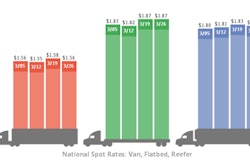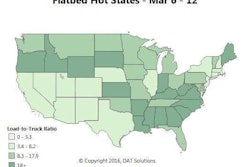More than half of U.S. states are either on the edge of tilting or have already tilted reefer rate momentum in carriers’ favor, said DAT’s Ken Harper in this week’s weekly spot market update, continuing the momentum seen in recent weeks for both the reefer segment and van and flatbed segments.
“Something like 29 states are showing load-to-truck ratios of 2.3 to 5.5,” Harper said. “Three loads for one truck is when the teeter totter starts tipping in the carrier’s favor.” Harper has noted in recent weeks the usual March blooming of freight and rates appears to be in effect, especially where spring weather’s already sprung, such as the South and Southwest.
Here’s a closer look at both van and reefer segments, along with heat maps showing the hottest states for each:
Reefer

The number of reefer loads posted to DAT’s loadboard last week climbed 10 percent, Harper says, while the number of available trucks rose just 1 percent. The two trends pushed the load-to-truck ratio to 3.3 and the country’s average reefer rate up 2 cents.
“Things are definitely improving for reefers, which is not surprising considering that this is when produce starts to move across the Southeast to the Southwest, and later to the Midwest and North,” Harper says. “With produce harvest under way, Florida continues to heat up. Rates are up on every major lane out of Miami, and they rose even more out of Lakeland due mostly to a 19-cent increase on the lane from Lakeland to Atlanta.”
Van

Van rates rose nationally by 3 cents, Harper says, on the heels of van freight volume rising 7 percent from the week prior and the number of available trucks unchanged.

“For vans, the SEC states are looking pretty strong – Arkansas, Mississippi, Alabama, Georgia and South Carolina,” Harper says. Other markets to see climbing van rates were Los Angeles (6 cents a mile), Chicago (2 cents), Dallas (1 cent) and Philadelphia, where the Philly to Boston lane alone rose 14 cents a mile, Harper says.











